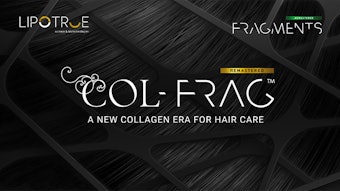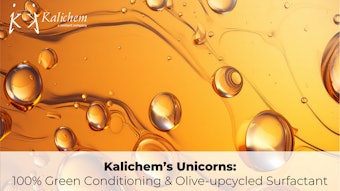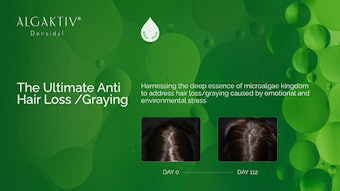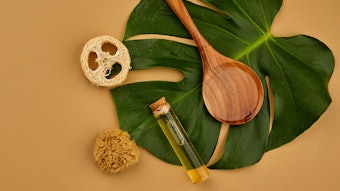
This article considers traditional and modern surfactants, silicones and alternatives, and looks to the future of these categories with specific examples from the industry. Some readers may remember that hair care before the 1980s was simpler with respect to the role of shampoos and the benefits they provided. Most brands essentially offered the consumer a dry, normal or greasy hair product variant in which the level and type of surfactant would be varied to deliver slightly different benefits. Light conditioning benefits were delivered via cationic polymers, just as modified guar would help to deliver frizz control and manageability. However, the inclusion of silicones in shampoos in the mid-1980s heralded a step-change in conditioning performance, starting with the creation of 2-in-1 shampoos.
Log in to view the full article
This article considers traditional and modern surfactants, silicones and alternatives, and looks to the future of these categories with specific examples from the industry. Some readers may remember that hair care before the 1980s was simpler with respect to the role of shampoos and the benefits they provided. Most brands essentially offered the consumer a dry, normal or greasy hair product variant in which the level and type of surfactant would be varied to deliver slightly different benefits. Light conditioning benefits were delivered via cationic polymers, just as modified guar would help to deliver frizz control and manageability. However, the inclusion of silicones in shampoos in the mid-1980s heralded a step-change in conditioning performance, starting with the creation of 2-in-1 shampoos.
Since then, over the last 30 years, the use of silicone in shampoo formulations has become more or less standard, enabling the creation of an almost exponential increase in creative new product variations. These offer new solutions for dry hair, slightly damaged hair, highly damaged hair, color care, curly hair, straight hair as well as hair that is exposed to pollution (detox variants). Underpinning this array of products and claims is a wide range of different dimethicones, dimethiconols and amodimethicone ingredients with different molecular weights, droplet sizes, emulsifiers and functionalities.
In more recent years, consumer interest in sulfate-free surfactants (mild or otherwise) and pressure to move away from palm kernel oil-based surfactants such as sodium and ammonium laureth sulfate – which are used in the vast majority of shampoo formulations globally – has led to the introduction of a range of new surfactants offering different benefits, such as superior mildness, biodegradability and sustainable sourcing. The use of silicones, particularly volatile silicones, is also under increasing scrutiny from consumers, influencers, NGOs and regulators.
Overall, it is safe to say that today’s formulation chemist faces significant challenges to create new commercially viable products that meet the challenge of superior performance and acceptable cost, along with compliance with emerging biodegradability and sustainability regulatory standards. On the plus side, the same chemist probably has access to more ingredients and technology options than ever before – to the extent that the range of choices can be overwhelming.
Surfactants in Hair Care
As a review, surfactants, short for surface-active agents, are amphiphilic molecules, meaning they have both hydrophobic (water-repelling) and hydrophilic (water-attracting) regions.1, 2 The primary role of surfactants is to help emulsify and solubilize oils and dirt on the hair and scalp. The hydrophobic tail of the surfactant binds to oils and grease, while the hydrophilic head allows the emulsified particles to be carried away by water during rinsing.
The role of surfactants in shampoos is multifaceted, as these ingredients play a crucial role in the cleaning, foaming and overall performance of the product. Surfactants also contribute to the formation of lather during washing, which while in and of itself does not necessarily enhance cleaning, is important to consumers, as they often associate a rich lather with effective cleansing.
Surfactants can also be used to control the viscosity of the shampoo formulation, which is essential for ensuring that it is thick enough such that when it is poured into the hand it does not run through the fingers. On the other hand, the shampoo must not be so thick that it is hard to apply and spread through the hair.
Anionic: As most readers know, there are three main classes of surfactant used in shampoos. The first and primary surfactant in most shampoo formulations are anionic, examples of which are sodium lauryl sulfate (SLS) or ammonium lauryl sulfate (ALS). More often, the milder ethoxylated versions of these surfactants, e.g., sodium laureth sulfate – where an ethylene oxide chain is inserted between the anionic head group and the hydrophobic tail – are used in the majority of commercial shampoo formulations. The main role of anionic surfactants is to provide excellent foaming and cleaning properties.
Nonionic: Nonionic surfactants such as cocamide MEA are often included as a secondary co-surfactant to enhance the mildness of the shampoo and reduce skin irritation.
Amphoteric/zwitterionic: Alternatively, amphoteric or zwitterionic surfactants such as cocamidopropyl betaine (CAPB) can also be used to improve the overall mildness of a formulation. In both cases, the nonionic or amphoteric surfactants interact with the primary anionic surfactant to lower the critical micellar concentration (CMC).
Processing and Substitutions
(From the editor: Please note the following bolded text has been corrected from the original version of this article appearing in our June 2024 edition.)
The starting ingredients for lauryl and laureth sulfates is lauryl alcohol, which is synthesized from either petrochemical-derived raw materials or natural sources such as coconut or palm kernel oil (PKO). Lauryl alcohol is sulfonated to produce the corresponding sulfate, sodium lauryl sulfate.
Prior to sulfonation, lauryl alcohol can undergo a process of ethoxylation to produce sodium laureth sulfate (SLES). Ethylene oxide, a petrochemical derivative, is used in this process.
Anionic surfactants derived from natural and petrochemical feedstocks can be used interchangeably; this choice is often driven by price fluctuations. However, it is not a simple swap given the different chain length distributions, along with differences in non-reacted feedstock in the final commercial product. This requires the formulation chemist to make small modifications to the formulation to deliver the same level product performance and manufacturability.
Another reason to use PKO-derived SLES is the ability to make naturally derived or plant-based claims if desired. However, the use of PKO as a feedstock presents other issues, which will be touched upon later.
For CAPB and CMEA, both are derived from coconut oil that is then reacted with dimethylaminopropylamine (DMAPA) and monoethanolamine (MEA), respectively. Both amines are usually derived from petrochemical sources.
In terms of cost effectively manufacturing shampoos, the use of laureth sulfate in combination with either CAPB or CMEA is the major formulation route.
Trends in Surfactants
While both ammonium and sodium laureth sulfate remain the dominant primary surfactants within the shampoo industry, clearly there are consumer concerns regarding the use of both petrochemical and palm-derived feedstocks in terms of their impact on the environment. Although most responsible manufacturers endeavor to source PKO from certified sustainable sources, nevertheless, there is pressure from consumers and organizations to move toward more environmentally friendly ingredients.
Another consumer belief, driven in part by some brands and hair stylists, is that laureth sulfate is particularly harsh and damaging to the hair. This has driven the increased demand for sulfate-free products in the market. Both of these external pressures have resulted in the creation and use of new generations of surfactants in personal care.
Bio-based surfactants: For example, there is increasing demand for surfactants derived from robust and certified renewable resources, such as plant-based or bio-based surfactants. These ingredients aim to address environmental concerns and contribute to sustainable and eco-friendly formulations. Surfactants derived from sugars, such as alkyl polyglucosides (e.g., lauryl glucoside) or from proteins (e.g., sodium lauroyl sarcosinate), are becoming popular due to their natural origin and mildness. However, it is important to emphasize that these surfactants are not intrinsically milder than the current sulfates, nor are they necessarily biodegradable.3
Mild surfactants: Formulators are also exploring surfactants that provide effective cleansing while being milder on the skin and hair. This trend is driven by consumer preferences for products that are gentle, especially for sensitive skin. Again, it is important to realize that many synthetic surfactants may offer mildness benefits.4
Biodegradability: Biodegradability is another critical factor in reducing the environmental impact of personal care products. As such, surfactants designed to break down more easily in the environment are gaining attention. Again, it is important to realize that a biodegradable surfactant is not necessarily sustainably sourced or even milder.5, 6
Sulfate-free: Finally, due to extensive influencer comments regarding the use of sulfate-containing shampoos, products that are sulfate-free have become an increasingly important segment of the hair care market – although the precise technical and consumer benefits for hair are yet to be determined. Also, as alluded to above, a sulfate-free shampoo does not necessarily mean a milder product, compared with mainstream sulfate-containing shampoos.
Overall, it is important, when selecting a specific novel surfactant, that the formulator (and marketing partners) fully understand its relevant properties along with any trade-offs such as cost and performance.
The following section highlights a number of emerging commercially available bio-surfactants to illustrate the new benefits and potential claims they can offer. These bio-surfactants have gained attention from formulators for their surface-active properties, including wetting, emulsification and foaming, and are increasingly being used in shampoos for their mild and sustainable cleaning properties.
Notably, the foam produced may be different from the dense lather associated with synthetic surfactants such as sulfates. Another critical challenge associated with these new classes of surfactant is their production cost compared to traditional surfactants. Additionally, their sourcing and purification need to be carefully managed to ensure product consistency and quality.
Rhamnolipids
Rhamnolipids7 are a class of glycolipid bio-surfactants produced by various microorganisms, most notably Pseudomonas aeruginosa. Some studies suggest that rhamnolipids may have potential benefits for the skin, including moisturizing and anti-inflammatory properties. In a shampoo formulation, this could contribute to a product that not only cleanses, but also offers mild scalp care benefits. Commerical examples of rhamnolipid surfactants are Rewoferm RL 100 (Evonik), Rheance One (Evonik) and JBR 320 and JBR 425 (Jeneil Biotech) [INCIs: Not Provided].
Sophorolipids
Sophorolipids are produced by yeast species, particularly Candida bombicola, and are another example of glycolipid bio-surfactants emerging on the market.8 They exhibit stability and effectiveness under a wide range of pH and temperature conditions, as well as in the presence of salts and organic solvents. Examples of these include Sophance LA-A (INCI: Glycolipids (and) Sodium Lactate; Evonik), EcoSense HC (INCI: Not Provided; Dow) and Holisurf and Holisurf LF (INCIs: Glycolipids; Holiferm).
While today, rhamnolipids and sophorolipids are the primary options commercially available for new bio-surfactant-based formulations, others likely to be seen in the future include the following.
Saponins
Saponins are natural surfactants found in various plants such as Quillaja saponaria (soapbark), and they have been used traditionally for cleaning purposes due to their foaming and detergent-like properties.9, 10 Saponins are glycosides composed of a hydrophilic sugar portion and a hydrophobic triterpene or steroid portion.
Mannosylerythritol Lipids (MELs)
Produced by yeast species such as Pseudozyma spp., MELs are increasingly being investigated for their potential application as eco-friendly alternatives to synthetic surfactants in shampoo formulas and other cosmetic applications.11-13
Trehalolipids
Trehalolipids are also a newly emerging class of shampoo bio-surfactants produced by various yeast and bacterial species.14
While all of these bio-surfactants have desirable properties with respect to sustainable sourcing and biodegradablity, there are challenges associated with their use. The variability in active content among different plant sources and batches can make it challenging to achieve consistent performance in formulations. Additionally, the foaming characteristics may differ from those of synthetic surfactants, along with the ability to achieve the required viscosity consistently.
Silicones in Hair Care
Silicones, as most readers know, are a class of synthetic compounds commonly used in hair care products such as shampoos and conditioners to provide various benefits, such as smoothing, detangling and shine via the effective lubrication of the fiber surface.15 There are different types of silicones as well, each with unique properties. Some commonly used silicones in hair care formulations are outlined below.
Dimethicone: Dimethicone is one of the most widely used silicones in hair care products. Also known as polydimethylsiloxane (PDMS), it can be synthesized in sizes ranging from a low molecular weight, low viscosity silicone fluid, to a very high molecular weight silicone gum.
Cyclomethicone and cyclopentasiloxane: These are lightweight silicones that evaporate quickly, leaving hair feeling smooth and silky.
Amodimethicone: Amodimethicone is a silicone derivative known for its ability to selectively deposit on damaged areas of the hair via positively charged amine groups.
Dimethiconol: Dimethiconol is a silicone polymer derived from dimethicone where the polymer is capped with hydroxyl groups as opposed to trimethylsiloxane groups in standard dimethicone polymers.
Dimethicone copolyol: Dimethicone copolyol is a water-soluble silicone that is easier to wash out compared to some other silicones.
Silicone quaterniums: Finally, silicone quaterniums are silicones that have been modified to include a quaternary ammonium compound. They offer conditioning and detangling benefits.
Silicone Properties and Applications
Dimethicones are the main silicone used in shampoos today that, as noted, were originally introduced into shampoo formulations in the mid-1980s to create what was marketed as 2-in-1 conditioning shampoos. Since then, their use has exploded across the majority of shampoo formulations to create a vast array of product variations that go beyond simple conditioning claims. This is due, in part, to the fact that in addition to being highly lubricating, dimethicones have viscoelastic properties. Such properties enable these ingredients to deliver a level of styling and manageability benefits, such as maintaining straighter hair for longer, or superior curl definition.
The obvious challenge of adding dimethicone to shampoo formulations is determining how to deposit onto a surface what is essentially an oily droplet – from a product that is designed to remove oils from surfaces. Two primary mechanisms are used to deposit silicone onto hair: polymer bridging deposition and direct transfer.
Polymer bridging involves the creation of a polymer surfactant complex (normally between quaternized quar gum and SLES) that can bind to silicone droplets and drag them onto the hair fiber surface. The most effective deposition results are generally with silicone droplets around 100-300 nm in diameter. Alternatively, direct transfer occurs when large silicone droplets (5-10 microns) simply collide with the hair fiber due to their size.
The deposition efficiency of the polymer-aided mechanism is significantly higher than direct transfer.16, 17 However, the polymer-aided deposition mechanism highly depends on controlling the phase behavior of the polymer-surfactant (SLES) complex. Moving to some of the next-generation surfactants discussed in the earlier section will require the development of new methods for effective deposition.
In addition, the use of silicones in hair care formulations is perceived negatively by some consumers, once again from influencer information or personal experience. As such, much like the sulfate-free trend, the silicone-free market segment is becoming increasingly important and has led to the emergence of a number of silicone alternatives.
Environmental Concerns
While silicones have been highly effective hair care ingredients, providing both functional and enhanced sensorial benefits, the movement away from their use is driven by a variety of reasons.18, 19
The Registration, Evaluation, Authorization and Restriction of Chemicals (REACH) regulation assessed the potential environmental effect of the cyclic silicones cyclotetrasiloxane (D4) and cyclopentasiloxane (D5). Based on this evaluation, D4 was deemed to meet the criteria for identification as a persistent, bio-accumulative and toxic (PBT) substance, and very persistent, very bioaccumulative (vPvB) substance. In addition, D5 meets the criteria for a vPvB substance.20 This means the concentration of D4/D5 as well as D6 in rinse-off cosmetic products placed on the market should be less than 0.1% by weight of either substance.
Dimethicones and dimethiconols are also suspected to be environmental toxins, to bioaccumulate, and could potentially be classified as microplastics.21 In addition to being non-biodegradable, silicone oils also have an impact on the environment due to their industrial production process, which has a relatively high carbon footprint.22
Responding to these concerns, the industry has invested significant resources to develop alternatives to silicones for hair care, driven by both the evolving regulatory environment and the consumer demand for effective yet sustainable solutions. Following are some future trends in silicone technologies for hair care.
Biodegradable and Renewable Silicone Alternatives
As consumers increasingly prioritize sustainability, there is growing interest in biodegradable silicone alternatives. Research into biodegradable silicone polymers and their derivatives – to develop materials that offer similar performance to traditional silicones but with reduced environmental impact – is ongoing.23 These alternatives may not be silicones in the traditional sense, but they can provide similar conditioning and smoothing effects while being more environmentally friendly.
For example, companies are exploring the use of silicone-like polymers derived from renewable plant sources such as bamboo, sugar cane or corn. These polymers can offer similar conditioning and smoothing benefits to traditional silicones but are biodegradable and more environmentally friendly. Illustrative examples are outlined next.
Olive: Biophytosebum from Sophim is a natural emollient with a reported dry feel, derived from the olive plant – a renewable raw material. Composed of esters (85-90%) and olive oil unsaponifiable matter (10-15% of which 8% squalene), it offers an alternative to volatile silicones.
Renewable microemulsion blend: Plantasil Micro (INCI: Dicaprylyl Ether (and) Decyl Glucoside (and) Glyceryl Oleate) from BASF is a transparent microemulsion based on natural, renewable raw materials. This conditioning agent is an optimized blended surfactant-oil system that is said to synergistically improve conditioning performance in rinse-off formulations when combined with cationics.
Synergistic sensory blends: LexFeel N5 MB (INCI: Diheptyl Succinate (and) Capryloyl Glycerin/Sebacic Acid Copolymer) from Inolex is designed to mimic the sensory and function of different viscosity dimethicones. The ingredient pairs a highly versatile plant-based copolymer with a soft and lightweight ester, creating a synergistic blend superior to one component alone.
Similarly, Seppic offers its Emogreen range of natural, plant-derived non-polar and liquid emollients, which the company claims can replace silicones to increase naturalness and biodegradability without sacrificing performance.
Macadamia: Floramac 10 (INCI: Ethyl Macadamiate) from Cargill is described as a non-volatile dry emollient with broad coupling and solubility characteristics. Derived from macadamia, it is designed to provide a silky feel similar to many silicones and silicone derivatives.
Biodegradable alternative: The SilSense Bio 5 emollient (INCI: C9-12 Alkane) from Lubrizol is designed as a biodegradable silicone alternative to D5 cyclopentasiloxane that reportedly provides the same performance and sensory feel in leave-on applications for skin care, hair care, hair color, sun care and makeup formulations.
Ester silicone replacement: Pelemol SR-100 (INCI: Coco-Caprylate/Caprate (and) Dimer Dilinoleyl Dimer Dilinoleate) from Phoenix Chemicals is an ester replacement for silicone fluids. It is RSPO certified, REACH and China compliant.
Alkyl polysaccharides: Alkyl polysaccharides are natural polymers derived from renewable sources such as starch or cellulose. They can be modified to impart silicone-like properties and they are biodegradable. These ingredients are used in some hair care formulations to provide conditioning and smoothing effects.26
Natural Oils
Another approach to replacing silicones in hair care formulations is the use of natural oils that can be incorporated into formulations on their own or as combinations with other oils or emollients. Unlike silicones, these ingredients have rich backstories, supporting new compelling consumer stories and claims, which are summarized below.
Coconut oil: Known for its moisturizing properties, coconut oil can penetrate the hair shaft to nourish and condition the hair from within. It helps to reduce protein loss and strengthens the hair.
Argan oil: Rich in antioxidants, vitamins and fatty acids, argan oil can hydrate and soften the hair, making it more manageable and reducing frizz.
Jojoba oil: Similar in composition to the natural oils produced by the scalp, jojoba oil is known to moisturize the hair without leaving a greasy residue. It can help balance the scalp's natural oils and promote hair health.
Shea butter: Derived from the nuts of the shea tree, shea butter is a natural emollient that softens and smooths the hair, making it more manageable and less prone to breakage.
Olive oil: Rich in vitamins and antioxidants, olive oil can help to moisturize and strengthen the hair, improving its elasticity and shine.
Avocado oil: Packed with vitamins A, D and E, as well as fatty acids, avocado oil can nourish and hydrate the hair, promoting elasticity and reducing breakage.
While all of these alternatives to silicone offer promising solutions for reducing the environmental impact of hair care products, it is important to note that they may not provide identical performance to traditional silicones. Formulators may need to optimize formulations and adjust product claims to meet consumer expectations while leveraging the sustainability benefits of these biodegradable alternatives.
‘More Sustainable’ Silicone
Taking a different approach, bio-based polyols derived from renewable sources such as vegetable oils or biomass can be used as starting materials for silicone synthesis. They can replace petroleum-based precursors, making the resulting silicones more environmentally friendly. Companies such as Dow are exploring the use of bio-based polyols in silicone production.25
Recycling silicone is another option to create more sustainable solutions. BeauSil RE-AMO 919 EM (INCI: Gluconamido Amodimethicone (and) Coco Glucoside) from CHT Silicones, for example, is a recycled sugar modified amodimethicone produced from recycled silicone. Here, end-of-life polymers are catalytically split into silicone monomers, modified, and then finally polymerized into a new modified silicone in virgin quality that can be used for personal and home care products.
This approach both significantly reduces the amount of energy required to produce the final amodimethicone, compared to current standard production methods, and is degradable post use. The silicone polymer will degrade first by UV or by the activity in the soil to smaller silicone molecules, which will be further degraded by microorganisms back to quartz, CO2 and water.26
Summary
Today’s formulation scientist faces an increasingly challenging and complex world in which the traditional palette of formulation ingredients to clean and care for hair becomes more restricted by regulators, is questioned by consumers and is under pressure from a range of NGOs. However, in response to this, technology companies and suppliers are creating ever more innovative ingredients that demonstrate either a significant improvement in ethical and sustainable sourcing and/or (bio)degradability profile, and overall carbon footprint to enable the creation of a new generation of shampoo and conditioner formulations with acceptable consumer performance.
This review has merely scratched the surface of the range of new materials emerging on the market and each area likely requires its own in-depth review. However, it attempts to illustrate what future shampoo ingredients or products may look like, some of which will become the new normal in years to come. However, none of these technologies should be considered as a “silver bullet” as challenges still remain in terms of matching the current mainstream technology with respect to both performance and cost.
References
1. Rieger, M.M. and Rhein, L.D. (2019). Surfactants: Fundamentals and applications in the petroleum industry. CRC Press.
2. Rosen, M.J. (2019). Surfactants and interfacial phenomena. John Wiley & Sons.
3. Sharma, S., et al. (2021). Green surfactants: Synthesis, properties and applications. Sustainable Chemistry and Pharmacy, 22, 100468.
4. Lode, O., et al. (2020). Mild surfactants for personal care. Cosmetics, 7(3) 58.
5. Tchabanenko, K., et al. (2019). Environmentally friendly surfactants: Design criteria and recent developments. Journal of Surfactants and Detergents, 22, 149–160.
6. Rhein, L.D. (2019). Sugar-based surfactants. Journal of Surfactants and Detergents, 22, 119–126.
7. Abdel-Mawgoud, A.M. and Lépine, F. (2010). Rhamnolipids: Diversity of structures, microbial origins and roles. Applied Microbiology and Biotechnology, 86(5), 1323–1336.
8. Morya, V.K. and Sabharwal, S. (2019). Commercial potential of sophorolipids: A review. Biotechnology Reports, 21, e00303.
9. Pauli, G.F., Case, R.J., Inui, T. and Wang, Y. (2006). New perspectives on natural products in TB drug research. Life Sciences, 78(5) 485–494.
10. Jolly, A., Kim, H., Moon, J.Y., Mohan, A. and Lee, Y.C. (2023, Dec 1). Exploring the imminent trends of saponins in personal care product development: A review. Industrial Crops and Products, vol 205.
11. Coherent Market Research. (Accessed 2024, May 11). Mannosylerythritol lipids market analysis. Available at https://www.coherentmarketinsights.com/market-insight/mannosylerythritol-lipids-market-3692
12. Morita, T., Fukuoka, T., Imura, T. and Kitamoto, D. (2013). Production of mannosylerythritol lipids and their application in cosmetics. Appl Microbiol Biotechnol, 97 4691–4700.
13. Ahmed-Ashtiani, H.-R., et al. (2020). Microbial bio-surfactants as key multifunctional ingredients for sustainable cosmetics. Cosmetics, 7(2), 46.
14. Varvaresou, V. and Iakovou, K. (2015, Sep). Bio-surfactants in cosmetics and biopharmaceuticals. Letters in Applied Microbiology, 61(3), pp 214-223.
15. Draelos, Z.D. (2006). Silicones: Skin and hair. In: Baumann, L. (ed.), Cosmetic dermatology: Principles and practice, pp. 335-338, McGraw-Hill.
16. Popescu, L., Sandulescu, N.P., Vasilescu, R., Vasile, I., Niculescu, M. and Popovici, D.F. (2012). Study of the mechanism of silicones deposition onto hair. Digest Journal of Nanomaterials and Biostructures, 7(2), 673-683.
17. Bury, H.J., Robbins, S.R. and Worden, M.G. (1996). Deposition of silicone from shampoos onto hair: The effects of silicone type and surfactant type. International Journal of Cosmetic Science, 18(2), 71-85.
18. Nori, M. (2022, Jul 26). Silicone alternative solutions for hair care. New York Society of Cosmetic Chemists. Available at https://nyscc.org/blog/silicone-alternative-solutions-for-hair-care/
19. Cerualo, C. (2023). To formulate with silicones or not? An eternal question. HPC Today, 18(6) 2023.
20. Moddaresi, M. (2018, Feb). Regulation update: Cyclosiloxanes in the EU. UL Prospector. Available at https://www.ulprospector.com/knowledge/7724/pcc-cyclosiloxane-d4-d5-regulation-update/
21. SuperZero. (2021, Apr). Silicones and hair care – An inconvenient truth. What are silicones and why are silicones used in the beauty industry? Available at https://superzero.com/blogs/stories/silicones-and-hair-care-the-inconvenient-truth
22. Personal Care. (2019, Mar). An alternate to silicone for hair care. Available (with login) at https://www.personalcaremagazine.com/story/28744/an-alternative-to-silicone-for-hair-care
23. Teixeira, M.A., Braga, M.E. and Duarte, C.M.M. (2020). Silicone-based polymers: Synthesis and properties. In Nunes, S.P. (ed.), Sustainable polymers, pp 339-366, Springer.
24. Sharma, N. and Rawat, P. (2020). Natural polymers in cosmetics and personal care products. In Choudhury, M. and Jan, S.U. (eds.), Biopolymers for cosmetics and personal care, pp. 253–268, Springer.
25. Renewable Carbon News. (2007, Sep 26). Odor-free bio-polyols with new Dow technology. Available at https://renewable-carbon.eu/news/odor-free-bio-polyols-with-new-dow-technology/
26. CHT. (Accessed 2024, May 11). Recycled silicones. Available at https://cht-silicones.com/products/emulsions/recycled-silicones










